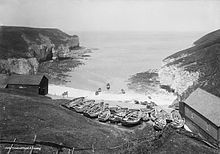Flamborough Head
Flamborough Head is a peninsula of 13 kilometers along the North Sea coast of Yorkshire ( England ) between the Book of Filey and Bridlington . It is one of chalk existing headland with pure white cliffs. There are two lighthouses on top of the cliff. The older one dates from 1669; he was in 1952 as a Grade II * put -Bauwerk a listed building and is today in the National Heritage List for England of Historic England out. The younger lighthouse was built in 1806.
The cliffs provide nesting opportunities for thousands of seabirds and are internationally important because of their geology.
Nature reserves
Flamborough Head has been designated a Flora-Fauna Habitat ( Special Area of Conservation ) by the British Government's Joint Nature Conservation Committee (JNCC) . On the headland there is an 83 hectare local nature reserve . The Flamborough Cliffs Nature Reserve is managed by the Yorkshire Wildlife Trust.
Site of Special Scientific Interest
The cliffs at Flamborough Head were declared a Site of Special Scientific Interest in 1952 because of their geological as well as their biological importance . The SSSI area extends from Sewerby around the peninsula to Reighton Sands. Most important biological characteristic are the estimated 200,000 nesting seabirds, including one of only two gannets - colonies on mainland Britain.
geology
The headland forms the only chalk cliff in the north. Within the SSSI one finds rock layers from the Upper Jurassic to the Upper Cretaceous , and the headland shows the complete sequence of the chalk layers of the North Sea basin, which were formed 100 to 70 million years ago. The different layers are known as Ferriby, Welton, Burnham and Flamborough chalk. The dramatic white cliffs form a stark contrast to the flat coastline at Holderness in the south, where the limestone layers are buried deep in the ground and the glacial clay above them is quickly eroded.
The Flamborough Cliffs have a greater number and variety of inhabited voids than any other chalk formation in Britain. The longest extend more than 50 meters from their entrance on the coast into the interior. There are also surf piers , rock gates and blowholes . Flamborough Head is rated as internationally significant by the Geological Conservation Review .
Birds
Seabirds such as gannets, Rissa and puffins breed in gro0er number on the cliffs. On the north side of the headland is the Bempton Cliffs bird sanctuary with a visitor center , managed by the Royal Society for the Protection of Birds . Seabird shooting at Flamborough Head was condemned by Professor Alfred Newton in his 1868 address to the British Association for the Advancement of Science . Local MP Christopher Sykes introduced the Sea Birds Preservation Act 1869 , the first law to protect wild birds in the UK.
Because it extends out into the sea, Flamborough Head attracts many migratory birds in the fall and is an important place to watch migrating seabirds. In easterly winds, many bird watchers keep an eye out from below the lighthouse. Later in autumn they comb the hedges and valleys for migrating land birds. There is an ornithological station at Flamborough Head .
Danes Dyke

Danes Dyke is a ditch about 3.2 km long that runs north to south and cuts the outermost 13 km 2 of the headland. The enclosed area with its two natural harbors in the north and south is easy to defend through the moat and the steep coast. Contrary to what the name suggests, the moat is of prehistoric origin. When it was excavated by Augustus Pitt Rivers in 1879, arrowheads from the Bronze Age were found . Danes Dyke is a nature reserve.
Individual evidence
- ↑ The Old Lighthouse [1083400] ( English ) In: National Heritage List for England . Historic England. Retrieved February 13, 2020.
- ^ Flamborough Outer Headland LNR. Natural England, accessed February 27, 2020 .
- ↑ map. Natural England, accessed February 27, 2020 .
- ↑ Yorkshire Wildlife Trust: Flamborough Cliffs Nature Reserve. Retrieved February 13, 2020 .
- ↑ map . Natural England. Retrieved August 18, 2014.
- ↑ a b c d SSSI citation sheet for Flamborough Head. Natural England, archived from the original on March 3, 2016 ; accessed on February 27, 2020 .
- ↑ RSPB Bird Guide: Gannet . Retrieved December 14, 2012.
- ^ English Nature: The Plain of Holderness Natural Area Profile (PDF) November 1977. Retrieved September 16, 2007.
- ^ The RSPB: Bempton Cliffs . Retrieved October 16, 2010
- ↑ Phyllis Barclay-Smith: The British contribution to bird protection . In: Ibis . 101, No. 1, 1959, pp. 115-122.
- ↑ Danes Dyke . Natural England. Retrieved August 4, 2013.
- ^ Map of Danes Dyke . Natural England. Retrieved August 4, 2013.
Web links
Coordinates: 54 ° 6 ′ 58 ″ N , 0 ° 4 ′ 59 ″ W.


